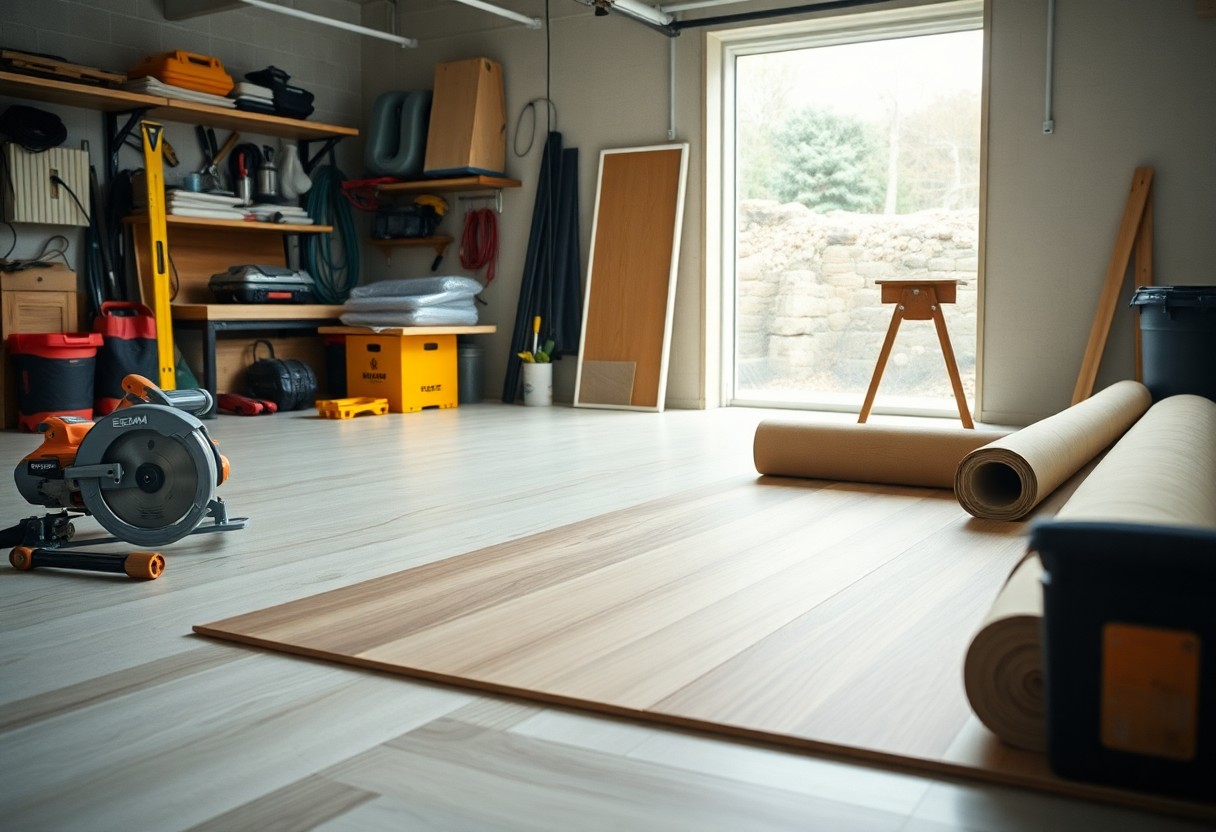Most homeowners face the dilemma of whether to tackle SPC vinyl flooring installation themselves or hire a professional. This decision can significantly impact your project’s outcome, budget, and timeline. By understanding the benefits and challenges of both approaches, you can make an informed choice that aligns with your skills and needs. In this guide, you’ll explore key factors to consider, helping you determine the best path for your flooring project.
Weighing the Pros and Cons: DIY vs. Professional Installation
Pros and Cons of DIY vs. Professional Installation
| DIY Installation | Professional Installation |
|---|---|
| Lower cost. | Expertise ensures quality. |
| Flexibility in scheduling. | Quicker completion time. |
| Personal satisfaction. | Access to professional-grade tools. |
| Opportunity for learning new skills. | Warranty often included. |
| Control over the installation process. | Less stress and hassle. |
| Potential for mistakes. | Higher costs, typically. |
| Time-consuming. | Dependence on contractor availability. |
| No access to troubleshooting assistance. | Professional expertise in problem-solving. |
| Requires a significant time commitment. | May offer design options unavailable to you. |
| Satisfaction from completing the job. | Assurance of long-lasting results. |
Cost Considerations: Budgeting for DIY or Professional Help
Budgeting for your SPC vinyl flooring installation requires evaluating the costs associated with both DIY and professional options. DIY installation saves money upfront, typically requiring only materials and tools; however, unexpected expenses for errors can arise. Professional installation, while more costly, often includes warranties and guarantees that protect against future issues. Balancing your immediate budget against long-term value is necessary to making the right choice for your home.
Time Investment: Evaluating Your Schedule and Deadlines
Your schedule largely influences the decision between DIY and professional installation. If you have the time and flexibility, a DIY project can be manageable. However, estimates suggest that professional installers can complete the job in a fraction of the time it may take you, especially if you lack experience. Weighing your current commitments against the time you can dedicate will guide you toward the most efficient choice.
Consider the impact of your project on daily life; a DIY installation can take several days or even weeks, depending on your skill level and availability. If you’re managing a busy household or have deadlines, hiring professionals may alleviate stress and allow you to continue your routine without significant interruptions. Additionally, professionals not only handle the installation quickly but can also work around your schedule, ensuring minimal disruption in your home life.

Skills Assessment: Are You Equipped to Handle the Job?
Assessing your skills is key to deciding whether to undertake SPC vinyl flooring installation. Consider your experience with similar home improvement projects. Familiarity with tools, precision in measuring, and understanding of flooring layouts can significantly influence your success. If you have prior experience in flooring or general DIY projects, you may be better positioned to tackle the installation yourself. However, if you often find home repairs overwhelming or have limited experience, hiring a professional might be the wise choice.
Necessary Tools and Equipment: What You’ll Need
Installing SPC vinyl flooring requires specific tools to achieve a professional finish. Essential equipment includes a utility knife, straight edge, measuring tape, vinyl flooring adhesive (if needed), a rubber mallet, spacers, and a floor roller. Additionally, a jigsaw or circular saw may be necessary for cutting pieces to fit around obstacles. Ensuring you have all the right tools at your disposal before starting can streamline the process and enhance your results.
Your Comfort Level: Recognizing Skill Gaps
Your comfort level with DIY projects plays a significant role in determining whether to proceed with installation or seek professional help. If you hesitate or feel anxious about using tools or following installation guidelines, it’s a sign that you may lack the necessary skills or confidence. A self-assessment can clarify your capabilities. Determine if you’re adept in reading instructions, performing precise measurements, and troubleshooting common flooring challenges.
Recognizing skill gaps is necessary to make an informed choice about your installation. If you find yourself unsure about handling critical steps—like achieving proper underlayment, ensuring a secure fit, or managing flooring expansion gaps—you might benefit from professional assistance. Conversely, if you feel confident about your work ethic and have successfully completed similar tasks, the challenge could be worthwhile. It’s also beneficial to consult with experienced friends or watch tutorial videos to gauge your readiness. Ultimately, trust your instincts about your abilities to either take on the project or leave it to the experts.
The Installation Process: A Deep Dive into the Steps
A seamless installation process can make all the difference in achieving a polished look for your SPC vinyl flooring. It involves several key steps, each requiring attention to detail to ensure the best outcome. Understanding and executing these steps will help you decide whether to take on the challenge yourself or enlist professional help.
Preparing the Subfloor: Setting the Stage for Success
Your subfloor plays a critical role in the longevity and appearance of your SPC vinyl flooring. Begin by cleaning the surface, removing debris, and ensuring it’s dry. Assess for any imperfections or moisture issues. Ideally, your subfloor should be level, stable, and smooth to provide the best foundation for your new flooring.
Laying Down the Vinyl: Techniques for a Flawless Finish
Laying down SPC vinyl requires precision for optimal results. Start by allowing your planks to acclimate in the room where they’ll be installed, which helps prevent expansion or contraction. Utilize a measuring tape to ensure accurate spacing, and employ a snap-lock mechanism for easy installation. Pay attention to staggered joints—this not only enhances the aesthetic but also strengthens the floor’s stability.
As you lay down the vinyl, utilize spacers around the perimeter to maintain proper expansion gaps, which will accommodate temperature fluctuations. Begin installation from the left corner, working your way towards the right. Carefully connect each plank and check for alignment and fit before securing them fully. For a clean finish, consider cutting the last plank to fit perfectly against the wall, using a utility knife for precise cuts. Keeping a steady pace and using consistent pressure while connecting pieces will ensure that the surface remains smooth and visually appealing.
Common Pitfalls: What to Avoid Regardless of Your Choice
Both DIY and professional installations come with their own unique challenges. Skipping steps, cutting corners, or overlooking important details can lead to long-term issues such as uneven flooring, gaps, or even damage to the subfloor. Identifying potential pitfalls before they arise helps in making informed decisions and ensures a smoother installation process.
Miscalculations in Measurements: The Impact on Material Usage
Accurate measurements are vital for a successful flooring installation. Miscalculating square footage can lead to either under-ordering or over-ordering materials. Under-ordering results in delays and mismatched planks, while over-ordering wastes money and resources. You should always double-check your measurements to ensure you account for hallways, alcoves, and waste during installation.
Ignoring Manufacturer Guidelines: Ensuring Quality and Warranty
Manufacturer guidelines provide important information for the proper installation and maintenance of SPC vinyl flooring. Ignoring these instructions can compromise the longevity of your floors and void warranty coverage. Specific recommendations regarding acclimation, underlayment, and installation techniques are designed to optimize performance. Ensure you closely follow these guidelines to maintain your warranty and enhance the durability of your flooring investment.
Many manufacturers detail critical steps that may seem minor but significantly impact the final outcome. For instance, failing to acclimate your SPC vinyl planks for the suggested 48 hours in the installation environment can cause expansion or contraction post-installation. Each brand may have unique requirements regarding adhesive types, temperature conditions, and specific installation methods, emphasizing the necessity of adherence to their published guidelines. Overlooking these importants not only jeopardizes the integrity of your installation but could also lead to costly repairs down the line.
Expert Insight: When to Call in the Professionals
Knowing when to enlist professional help can save you time and money in the long run. If you’re facing tight deadlines, lack the necessary tools, or simply want the peace of mind that comes with expert installation, professionals are a solid choice. Their experience with various flooring types and installation techniques can significantly reduce the risk of errors that could lead to costly repairs later. Trusting experts ensures the job is done right the first time, allowing you to enjoy your new SPC vinyl flooring without worry.
Complex Installations: Recognizing Job Limitations
Some flooring situations present unique challenges that may exceed your DIY capabilities. For instance, intricate patterns, uneven subfloors, or extensive square footage often require advanced skills and tools for a flawless finish. If you’re not equipped to manage complex cuts or transitions, a professional’s expertise can be invaluable, ensuring that everything aligns perfectly and functions seamlessly.
Long-Term Value: Assessing the Benefits of Professional Expertise
Choosing a professional installation can enhance the longevity and performance of your SPC vinyl flooring. Qualified installers typically offer warranties on their work, providing you with added security. Their knowledge of the best practices and latest techniques not only minimizes mistakes but can also contribute to increased durability and aesthetics. Additionally, they can advise on maintenance and care, potentially extending the life of your flooring by years.
Investing in professional installation might seem costly upfront, but the long-term benefits far outweigh the initial expense. Many professionals have years of experience and can prevent issues such as improper adhesive use, inadequate acclimation, or poor subfloor preparation. This expertise can lead to fewer repairs or replacements down the road. Homeowners who opt for professionals often see enhancements in overall home value, bolstering both aesthetic appeal and marketability. Properly installed SPC vinyl flooring can last for decades, making professional guidance a wise investment for your property.
Summing up
Presently, deciding between DIY or professional installation for your SPC vinyl flooring requires careful consideration of your skills, time, and budget. If you’re confident in your abilities and have the necessary tools, a DIY approach can save you money and provide a sense of accomplishment. However, if you prefer a flawless finish and want to avoid potential mishaps, hiring a professional may be the better choice. Ultimately, your decision should align with your comfort level and the importance you place on the installation’s quality.


